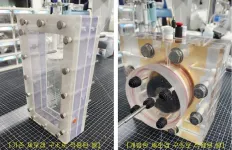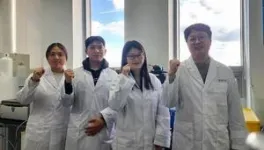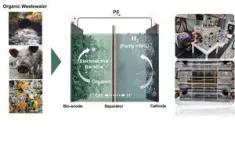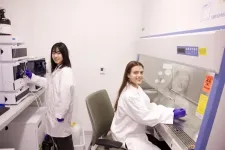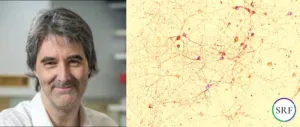(Press-News.org) Dr. Jwa Eunjin and her research team at the Korea Institute of Energy Research (KIER) have achieved a significant breakthrough in clean energy technology. The team has successfully enhanced a crucial component of a bio-electrochemical cell, enabling more efficient hydrogen production from microorganisms found in waste. This advancement resolves longstanding power loss challenges in conventional processes, offering a transformative pathway toward large-scale, cost-effective hydrogen production.
Biogas, a renewable gas generated during the microbial decomposition of organic waste, has emerged as a promising source for clean hydrogen production. Through processes like steam reforming or pyrolysis at elevated temperatures, biogas can be converted into hydrogen — a key player in the global transition to carbon neutrality. However, existing production methods face critical hurdles. These processes not only emit carbon dioxide as a byproduct but also demand substantial energy to sustain high-temperature conditions, posing significant challenges to large-scale commercialization.
To address these challenges, leading countries such as the United States and Europe are actively researching hydrogen production processes using bio-electrochemical cells. In this process, waste and electricity are supplied to the bio-electrochemical cell, where microorganisms consume organic matter, releasing electrons and hydrogen ions that combine to produce hydrogen gas.
* Bio-Electrochemical Cell (BEC): A system that combines the biological metabolic activity of microorganisms with electrochemical reactions to produce energy (such as electricity, hydrogen, or methane) or valuable chemical substances. It is gaining attention as an eco-friendly technology capable of simultaneously treating waste and generating energy.
Unlike traditional hydrogen production methods, the bio-electrochemical cell (BEC) process offers a more sustainable and cost-efficient solution. By operating at low temperatures and emitting significantly less carbon dioxide, BEC technology aligns with global decarbonization goals. However, scaling up the process presents a critical challenge. As system size increases, the pathways for electrochemical reaction materials become longer, resulting in higher internal resistance and increased power loss. This limitation poses a significant barrier to large-scale commercialization, highlighting the need for further technological advancements to improve system efficiency and scalability.
To overcome the power loss issues of conventional bio-electrochemical cells, the research team developed a proprietary improvement to the basic unit of the cell and applied it to the hydrogen production process. The process utilizing the newly developed cell achieved 1.2 times higher hydrogen productivity and more than 1.8 times higher electron production compared to existing bio-electrochemical hydrogen production processes.
The research team has introduced a groundbreaking innovation to the bio-electrochemical cell: a proprietary Zero-Gap technology. This advanced design minimizes the distance between the cell's electrodes and separator, significantly reducing electrical resistance and optimizing reaction efficiency. By creating a more direct pathway for electrochemical reactions, Zero-Gap technology enables faster electron transfer and more efficient hydrogen production. Widely adopted in cutting-edge electrochemical systems, this approach is a critical step forward in improving the scalability and commercial viability of bio-electrochemical cells.
However, conventional zero-gap structures are typically designed by stacking electrodes and membranes in a sandwich-like configuration. During large-scale implementation, this structure can lead to pressure imbalances, creating small gaps between the electrodes and membranes. These gaps cause localized efficiency drops and an increase in electrical resistance, hindering overall process performance.
In contrast, the zero-gap structure developed by the research team features a cylindrical lid that applies uniform pressure to the back of the electrode as it closes, ensuring complete adhesion between the electrode and the separator. This design can be applied consistently even in large-scale processes, making it a key innovation for the commercialization of bio-electrochemical cells.
The research team successfully applied the developed bio-electrochemical cell to the hydrogen production process, resulting in 1.8 times more electron production and a 1.2-fold increase in hydrogen output compared to conventional processes. The same performance was maintained in pilot-scale experiments, a critical step toward large-scale implementation. This achievement was officially certified by the Korea Testing Laboratory (KTL), further validating its effectiveness.
Dr. Jwa Eunjin, the lead researcher, stated, "This technological development not only addresses the environmental and economic challenges of processing organic waste in Korea but also represents a significant breakthrough in the high-efficiency production of clean hydrogen energy." She added, "The commercialization of the high-performance bio-electrochemical cell we developed is expected to make a substantial contribution to achieving carbon neutrality and transitioning to a hydrogen-based society.“
Meanwhile, this research was conducted with support from the Future Hydrogen Original Technology Development Program of the National Research Foundation of Korea. The results were published in Science of The Total Environment, a globally renowned journal in the field of environmental science.
END
Bio-electrochemical cell producing hydrogen from microorganisms in waste: Pathway to large-scale implementation unveiled
KIER develops bio-electrochemical cell with proprietary technology, resolving power loss issues in large-scale processes
2024-12-18
ELSE PRESS RELEASES FROM THIS DATE:
People from some racial and ethnic groups may face barriers to obtaining obesity medications
2024-12-18
Asians, non-Hispanic Blacks and Hispanics were significantly less likely than whites to use obesity-management medications to lower their weight compared with whites, new research suggests. The differences could not be fully explained by income or education level, health insurance coverage or clinical need.
The study, published in the peer-reviewed Journal of Racial and Ethnic Health Disparities, is one of the few to compare the use of obesity-management medications across racial and ethnic groups, and the first to consider ...
Microplastics in the air may be leading to lung and colon cancers
2024-12-18
A review of 3,000 studies also suggests these minute plastic air particles may be causing male and female infertility.
Tires and degrading garbage shed tiny pieces of plastic into the air, creating a form of air pollution that UC San Francisco researchers suspect may be causing respiratory and other illnesses.
A review of some 3,000 studies implicates these particles in a variety of serious health problems. These include male and female infertility, colon cancer and poor lung function. The particles also may contribute to chronic pulmonary inflammation, ...
Elevated levels of ‘forever chemicals’ found in several smartwatch wrist bands
2024-12-18
Smartwatches and fitness trackers have become ubiquitous forms of wearable tech, accompanying many people throughout their days (and nights). But they may expose the skin to so-called forever chemicals in the process. More expensive wristbands made from fluorinated synthetic rubber revealed particularly high amounts of one forever chemical, perfluorohexanoic acid (PFHxA), according to a study published in ACS’ Environmental Science & Technology Letters.
“This discovery stands out because of the very high concentrations of one type of forever chemical found in items that are in prolonged contact with ...
Potentially harmful bacteria slip through antimicrobial showerheads
2024-12-18
To guard against harmful waterborne pathogens, many consumers, including managers of health-care facilities, install antimicrobial silver-containing showerheads. But in ACS ES&T Water, researchers now report that these fixtures are no “silver bullet.” In real-world showering conditions, most microbes aren’t exposed to the silver long enough to be killed. However, the composition of rare microbes in water from these showerheads varied with each type of fixture tested.
The stream of droplets and fine mist that form during a shower could be inhaled or swallowed. Installing showerheads ...
Children’s Hospital Colorado research transforms the standard of care for childhood cancer
2024-12-18
After participating in a global clinical trial, leaders at the Children’s Hospital Colorado (Children’s Colorado) Center for Cancer and Blood Disorders and the University of Colorado Cancer Center are celebrating results so transformative, they change the standard of care for treating most kids with B-cell acute lymphoblastic leukemia (B-ALL), the most common form of childhood cancer. The new therapy is less toxic than traditional chemotherapy, resulting in significantly fewer side effects like severe infections, mouth sores and bone marrow suppression, ...
Nature’s instructions: How fungi make a key medicinal molecule
2024-12-18
For roughly a century, ever since Alexander Fleming’s accidental discovery of penicillin in 1928, fungi have proven to be a goldmine for medicines. They’ve provided treatments for a wide range of diseases, from infections and high cholesterol to organ rejection and even cancer.
However, the process by which fungi synthesize some of their most potent compounds remains opaque. This is especially true of cyclopentachromone, a key building block in fungal products whose derivatives have shown promise in fighting cancer and reducing inflammation, among other medicinal properties.
Reading Nature’s Instructions
While chemists have made progress in creating ...
Michael Courtney of Turku Bioscience Center receives grant for research on SYNGAP1 missense variants and drug repurposing from SynGAP Research Fund (SRF) dba Cure SYNGAP1
2024-12-18
Mill Valley, CA – December 18, 2024 – The SynGAP Research Fund 501(c)(3) dba Cure SYNGAP1 announced a $108,867 grant to Dr. Michael Courtney and Dr. Li-Li Li at the Turku Bioscience Centre, University of Turku, Finland, to advance their research on SYNGAP1 missense variants. Their project seeks to better understand the functional impact of these mutations and explore drug repurposing as a potential therapeutic approach.
Dr. Courtney’s team will use advanced phenotyping techniques to assess how SYNGAP1 missense variants impact the protein’s ...
Sexism is a risk factor for memory decline among women
2024-12-18
NEW YORK, NY (Dec. 18, 2024)--Women born in the most sexist U.S. states experience faster memory decline in later years compared to women born in the least sexist states, a new study by researchers at Columbia University Vagelos College of Physicians and Surgeons has found.
The difference between being born in the most versus the least sexist state was equivalent to nine years of cognitive aging.
The study is one of a growing number of studies that have investigated links between structural sexism and health. Structural sexism, like structural racism, does not refer to personal incidences but to inequality in resources and power ...
Study supports new blood-based biomarker to detect early brain changes leading to cognitive impairment and dementia
2024-12-18
To identify and follow blood vessel-related changes in the brain that contribute to cognitive impairment and dementia, researchers and clinicians typically rely on MRI to evaluate “downstream” biological markers – those at the end of a cascade of events. But a multicenter study led by UCLA researchers could lead to a cost-effective blood test to identify changes occurring near the top of the chain, potentially identifying at-risk patients at an earlier stage.
“We studied a protein in the blood that is critical in the formation ...
Genetic testing changes course of care in children with neurodevelopmental conditions
2024-12-18
Adding genetic testing to the evaluation of pediatric patients with neurodevelopmental disorders (NDD) resulted in more individualized care, including changes in medication, referrals to clinical trials or specialists, and surveillance for potential medical issues, according to a new UCLA Health study.
Children that present with neurodevelopmental differences, such as autism or global development delay, have high rates of co-occurring neuropsychiatric conditions, and almost half have an underlying genetic diagnosis. The current practice of relying on primary care doctors to refer patients to specialists can create delays in diagnoses and interventions for children ...
LAST 30 PRESS RELEASES:
NTP-enhanced lattice oxygen activation in Ce-Co catalysts for low-temperature soot combustion
Synergistic interface engineering in Cu-Zn-Ce catalysts for efficient CO2 hydrogenation to methanol
COVID-19 leaves a lasting mark on the human brain
Scientists use ultrasound to soften and treat cancer tumors without damaging healthy tissue
Community swimming program for Black youth boosts skills, sense of belonging, study finds
Specific depressive symptoms in midlife linked to increased dementia risk
An ‘illuminating’ design sheds light on cholesterol
Who is more likely to get long COVID?
Study showcases resilience and rapid growth of “living rocks”
Naval Research Lab diver earns Office of Naval Research 2025 Sailor of the Year
New Mayo-led study establishes practical definition for rapidly progressive dementia
Fossil fuel industry’s “climate false solutions” reinforce its power and aggravate environmental injustice
Researchers reveal bias in a widely used measure of algorithm performance
Alcohol causes cancer. A study from IOCB Prague confirms damage to DNA and shows how cells defend against it
Hidden viruses in wastewater treatment may shape public health risks, study finds
Unlock the power of nature: how biomass can transform climate mitigation
Biochar reshapes hidden soil microbes that capture carbon dioxide in farmland
Reducing saturated fat intake shows mortality benefit, but only in high-risk individuals
Manta rays create mobile ecosystems, study finds
Study: Mixed results in using lipoic acid to treat progressive multiple sclerosis
Norbert Holtkamp appointed director of Fermi National Accelerator Laboratory
New agentic AI platform accelerates advanced optics design
Biologists discover neurons use physical signals — not electricity — to stabilize communication
Researchers discover that a hormone can access the brain by hitchhiking
University of Oklahoma researcher awarded funding to pursue AI-powered material design
Exploring how the visual system recovers following injury
Support for parents with infants at pediatric check-ups leads to better reading and math skills in elementary school
Kids’ behavioral health is a growing share of family health costs
Day & night: Cancer disrupts the brain’s natural rhythm
COVID-19 vaccination significantly reduces risk to pregnant women and baby
[Press-News.org] Bio-electrochemical cell producing hydrogen from microorganisms in waste: Pathway to large-scale implementation unveiledKIER develops bio-electrochemical cell with proprietary technology, resolving power loss issues in large-scale processes
